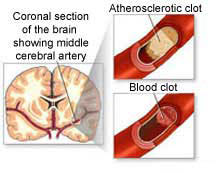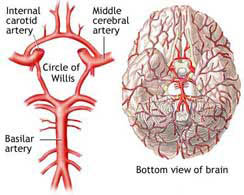Health Topic: Stroke

Definition
A stroke is an interruption of the blood supply to any part of the
brain. A stroke is sometimes called a "brain attack."
Causes, Incidence, and Risk Factors
Every 45 seconds, someone in the United States has a stroke. A stroke
can happen when:
- A blood vessel carrying blood to the brain is blocked by a blood
clot. This is called an ischemic stroke.
- A blood vessel breaks open, causing blood to leak into the brain.
This is a hemmorhagic stroke.
If blood flow is stopped for longer than a few seconds, the brain
cannot get blood and oxygen. Brain cells can die, causing permanent
damage.
Ischemic Stroke
This is the most common type of stroke. Usually this type of stroke
results from clogged arteries, a condition called atherosclerosis.
Fatty deposits and blood platelets collect on the wall of the arteries,
forming a sticky substance called plaque. Over time, the plaque
builds up. Often, the plaque causes the blood to flow abnormally,
which can cause the blood to clot. There are two types of clots:
- A clot that stays in place in the brain is called a cerebral
thrombus.
- A clot that breaks loose and moves through the bloodstream to
the brain is called an cerebral embolism.
Another important cause of cerebral embolisms is a type of arrhythmia
called atrial fibrillation. Other causes of ischemic stroke include
endocarditis and the use of a mechanical heart valve. A clot can
form on the artificial valve, break off, and
travel to the brain. For this reason, those with
mechanical heart valves must take blood thinners.
Hemorrhagic Stroke
 A second major cause of stroke is bleeding in the brain, known as
hemorrhagic stroke. This can occur
when small blood vessels in the brain become weak and burst. Some
people have defects in the blood vessels of the brain that make
this more likely.
The flow of blood after the blood vessel ruptures damages brain
cells.
A second major cause of stroke is bleeding in the brain, known as
hemorrhagic stroke. This can occur
when small blood vessels in the brain become weak and burst. Some
people have defects in the blood vessels of the brain that make
this more likely.
The flow of blood after the blood vessel ruptures damages brain
cells.
Stroke Risks
High blood pressure is the number one cause of stroke. The risk
of stroke is also increased by age, family history of stroke, smoking,
diabetes, high cholesterol, and heart disease.
Certain medications increase the chances of clot formation, and
therefore chances for a stroke. Birth control pills can cause blood
clots, especially in woman who smoke and who are older than 35.
Men have more strokes than women. But, women have a risk of stroke
during pregnancy and the weeks immediately after pregnancy.
Cocaine use, alcohol abuse, head injury, and bleeding disorders
also increase the risk of bleeding into the brain.
Symptoms
The symptoms of stroke depend on what part of the brain is damaged.
Usually, a SUDDEN development of one or more of the following indicates
a stroke:
- Weakness or paralysis of an arm, leg, side of the face, or any
part of the body
- Numbness, tingling, decreased sensation
- Vision changes
- Slurred speech, inability to speak or understand speech, difficulty
reading or writing
- Swallowing difficulties or drooling
- Loss of memory
- Vertigo (spinning sensation)
- Loss of balance or coordination
- Personality changes
- Mood changes (depression, apathy)
- Drowsiness, lethargy, or loss of consciousness
- Uncontrollable eye movements or eyelid drooping
If one or more of these symptoms is present for less than 24 hours,
it may be a transient ischemic attack (TIA). A TIA is a temporary
loss of brain function and a warning sign for a possible future
stroke.
Signs and Tests
In diagnosing a stroke, knowing how the symptoms developed is important.
The symptoms may be severe at the beginning of the stroke, or they
may progress or fluctuate for the first day or two. Once there is
no further deterioration, the stroke is considered completed.
During physical exam, a doctor will look for specific neurologic,
motor, and sensory deficits. These often correspond closely to the
location of the injury in the brain. An examination may show changes
in vision or visual fields, abnormal reflexes, abnormal eye movements,
muscle weakness, decreased sensation, and other changes. A "bruit"
(an abnormal sound heard with the stethoscope) may be heard over
the carotid arteries of the neck. There may be signs of atrial fibrillation.
Treatment
A stroke is a medical emergency. Doctors have begun to call it a
"brain attack" to stress that getting treatment immediately
can save lives and reduce disability. Treatment varies, depending
on the severity and cause of the stroke. The goal is to get the
person to the emergency room immediately, determine if he or she
is having a bleeding stroke or a stroke from a blood clot, and start
therapy -- all within 3 hours of when the stroke began.
IMMEDIATE Treatment
Thrombolytic medicine, like tPA, breaks up blood clots and can restore
blood flow to the damaged area. People who receive this medicine
are more likely to have less long-term impairment. However, to receive
thrombolytics a person must be evaluated and treated by a specialized
stroke team within 3 hours of when the symptoms start. If the stroke
is caused by bleeding rather than clotting, tPA can make the damage
worse -- so care is needed to diagnose the cause before giving treatment.
In other circumstances, blood thinners such as heparin and coumadin
are used to treat strokes. Aspirin and other anti-platelet agents
may be used as well.
For hemorrhagic stroke, surgery is often required to remove pooled
blood from the brain and to repair damaged blood vessels.
Expectations (Prognosis)
The long-term outcome from a stroke depends on the extent of damage
to the brain, the presence of any associated medical problems, and
the likelihood of recurring strokes.
Of those who survive a stroke, many have long-term disabilities,
but about 10% of those who have had a stroke recover most or all
function. Fifty percent are able to be at home with medical assistance
while 40% become residents of a long-term care facility like a nursing
home.
 Complications Complications
- Problems due to loss of mobility (joint contractures, pressure
sores)
- Permanent loss of movement or sensation of a part of the body
- Bone fractures
- Muscle spasticity
- Permanent loss of brain functions
- Reduced communication or social
interaction
- Reduced ability to function or
care for self
- Decreased life span
- Side effects of medications
- Aspiration
- Malnutrition
Prevention
To help prevent a stroke:
- Get screened for high blood pressure at least every two years,
especially if there is a family history of high blood pressure.
- Get regular cholesterol checks.
- Treat high blood pressure, diabetes, high cholesterol, and heart
disease if present.
- Follow a low-fat diet.
- Quit smoking.
- Exercise regularly.
- Lose weight (if overweight).
- Avoid excessive alcohol use (no more than 1 to 2 drinks per
day).
|

